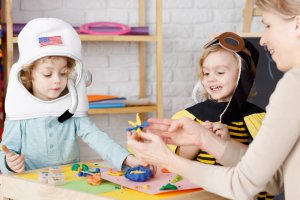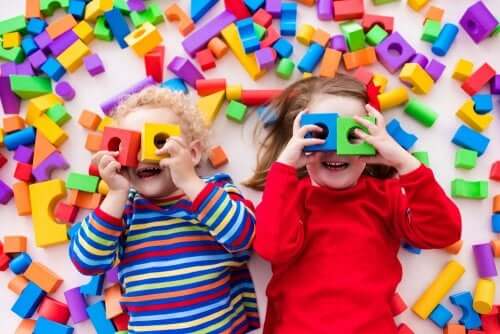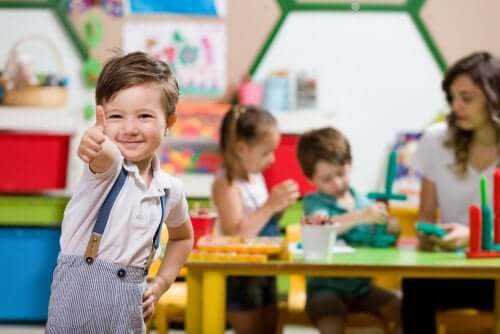Heuristic Play: Discovering, Experimenting and Exploring

Play, as we all know, is an innate childhood activity. Playing is how children learn things and understand the world around them, as well as themselves. In this article, we’ll talk about heuristic play.
Heuristic play
The games vary according to the child’s developmental stage. From 12 to 24 months, children are in the period of sensory-motor development. They begin to have greater autonomy in their movements and, little by little, they begin to coordinate them. Therefore, their playing and learning possibilities multiply.
At the 12- to 24-month stage, children need to explore and discover for themselves how things behave. Thus, they need many objects to experiment with. From nursery school, you can provide them this opportunity through heuristic play. This type of play favors manipulation, experimentation, and discovery.
Heuristic play is for children 12-24 months old. It was developed by English pedagogue Elinor Goldschmied and put into practice in collaboration with educators from England, Scotland, Italy, and Spain.

It consists of offering a group of children a number of objects of different types and materials for them to play and experiment freely with, without the intervention of adults, for a certain time and in a controlled environment. The child is the protagonist of their own learning. Thus, they learn and discover on their own.
The characteristics of heuristic play
It encourages children to manipulate, observe and explore many different objects and materials, as well as interact and discover with their gaze, touch and mouth.
By discovering, the child becomes aware of the laws of nature (gravity, balance, speed, etc.) and of the properties of objects (dimension, volume, weight, color, texture, etc.).
There’s no error; the actions and relationships a child builds with objects will be as correct and adequate as those of another child, since the possibilities are endless. Thus, nothing determines what’s right or wrong.
Play conflicts are eliminated, since all children have enough objects and no one asks them to share (a premature attitude, even for this age).
Benefits of heuristic play
Above all, it’s the pleasure that children find in the materials and their actions, in addition to achieving the following goals:
- Promoting concentration.
- Developing eye-hand coordination.
- Coordinating movements with both hands. For example, stacking, fitting together, covering, uncovering, etc.
- Learning the cause-effect relationship, concepts such as inside-outside or full-empty.
- Sorting and distinguishing between different object categories.
- Learning vocabulary.
- Gaining sensory perception of objects.
What do you need?
- Varied objects. It’s best if they’re natural (wood, cardboard, metal, cork, leather…). But you can also use recycled materials. You’ll need to have many different varied objects, at least 15 different ones, and about 50 units of each.
- Cloth bags in which you’ll store all the same elements of each type, called collections. On each bag, draw or write the object it contains.
- Containers. Usually baskets, jars, or boxes of different sizes to store the objects. You need three or four for each child.

How to organize a heuristic play session
A game session lasts approximately 50 minutes. This time includes preparation, play, and pickup. A maximum of eight to 10 children participate in one session.
- Preparation. The educator prepares the play space. It must be spacious so that children have freedom of movement. In turn, it must promote concentration. Thus, the educator needs to remove games and objects that can cause distractions. Then, the educator has to prepare eight game stations. Each station has to consist of three to four containers and seven or eight pieces from the object collections.
- Play. Children can freely explore and manipulate objects. They have infinite possibilities: fill, empty, open, cover, stack, roll, cuddle…
- Pick up. The educator must set aside 15 minutes for the children to order and pick up the objects. The children, with the help of the educator, collect and classify the objects; they consider this part of the game. In turn, the children develop new vocabulary, since the educator indicates the name, the quantity, and the place the objects are found.
The role of the educator
Their role is that of facilitator and observer. They must remain vigilant and observe how children interact with the objects and write down what they find interesting. The educator doesn’t encourage, suggest, praise, nor direct.
If they see at any moment that the objects are too scattered in the play space, they should rearrange them in silence to avoid distracting the children. Thus, they should only intervene if one of the children starts throwing things and disturbing the others. In this case, it’s best to offer that child a container and encourage them to put objects inside it.
Play, as we all know, is an innate childhood activity. Playing is how children learn things and understand the world around them, as well as themselves. In this article, we’ll talk about heuristic play.
Heuristic play
The games vary according to the child’s developmental stage. From 12 to 24 months, children are in the period of sensory-motor development. They begin to have greater autonomy in their movements and, little by little, they begin to coordinate them. Therefore, their playing and learning possibilities multiply.
At the 12- to 24-month stage, children need to explore and discover for themselves how things behave. Thus, they need many objects to experiment with. From nursery school, you can provide them this opportunity through heuristic play. This type of play favors manipulation, experimentation, and discovery.
Heuristic play is for children 12-24 months old. It was developed by English pedagogue Elinor Goldschmied and put into practice in collaboration with educators from England, Scotland, Italy, and Spain.

It consists of offering a group of children a number of objects of different types and materials for them to play and experiment freely with, without the intervention of adults, for a certain time and in a controlled environment. The child is the protagonist of their own learning. Thus, they learn and discover on their own.
The characteristics of heuristic play
It encourages children to manipulate, observe and explore many different objects and materials, as well as interact and discover with their gaze, touch and mouth.
By discovering, the child becomes aware of the laws of nature (gravity, balance, speed, etc.) and of the properties of objects (dimension, volume, weight, color, texture, etc.).
There’s no error; the actions and relationships a child builds with objects will be as correct and adequate as those of another child, since the possibilities are endless. Thus, nothing determines what’s right or wrong.
Play conflicts are eliminated, since all children have enough objects and no one asks them to share (a premature attitude, even for this age).
Benefits of heuristic play
Above all, it’s the pleasure that children find in the materials and their actions, in addition to achieving the following goals:
- Promoting concentration.
- Developing eye-hand coordination.
- Coordinating movements with both hands. For example, stacking, fitting together, covering, uncovering, etc.
- Learning the cause-effect relationship, concepts such as inside-outside or full-empty.
- Sorting and distinguishing between different object categories.
- Learning vocabulary.
- Gaining sensory perception of objects.
What do you need?
- Varied objects. It’s best if they’re natural (wood, cardboard, metal, cork, leather…). But you can also use recycled materials. You’ll need to have many different varied objects, at least 15 different ones, and about 50 units of each.
- Cloth bags in which you’ll store all the same elements of each type, called collections. On each bag, draw or write the object it contains.
- Containers. Usually baskets, jars, or boxes of different sizes to store the objects. You need three or four for each child.

How to organize a heuristic play session
A game session lasts approximately 50 minutes. This time includes preparation, play, and pickup. A maximum of eight to 10 children participate in one session.
- Preparation. The educator prepares the play space. It must be spacious so that children have freedom of movement. In turn, it must promote concentration. Thus, the educator needs to remove games and objects that can cause distractions. Then, the educator has to prepare eight game stations. Each station has to consist of three to four containers and seven or eight pieces from the object collections.
- Play. Children can freely explore and manipulate objects. They have infinite possibilities: fill, empty, open, cover, stack, roll, cuddle…
- Pick up. The educator must set aside 15 minutes for the children to order and pick up the objects. The children, with the help of the educator, collect and classify the objects; they consider this part of the game. In turn, the children develop new vocabulary, since the educator indicates the name, the quantity, and the place the objects are found.
The role of the educator
Their role is that of facilitator and observer. They must remain vigilant and observe how children interact with the objects and write down what they find interesting. The educator doesn’t encourage, suggest, praise, nor direct.
If they see at any moment that the objects are too scattered in the play space, they should rearrange them in silence to avoid distracting the children. Thus, they should only intervene if one of the children starts throwing things and disturbing the others. In this case, it’s best to offer that child a container and encourage them to put objects inside it.
This text is provided for informational purposes only and does not replace consultation with a professional. If in doubt, consult your specialist.








